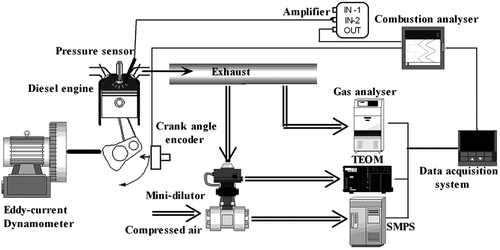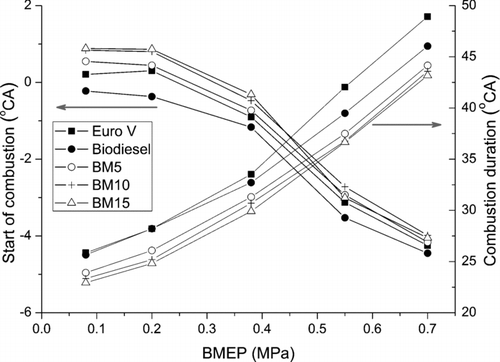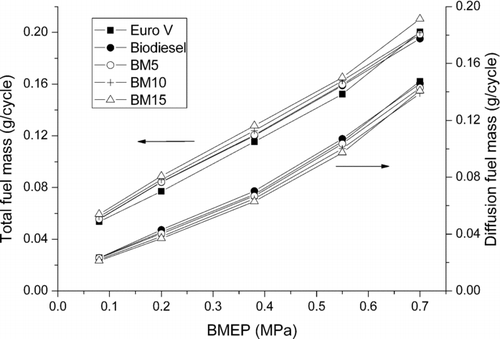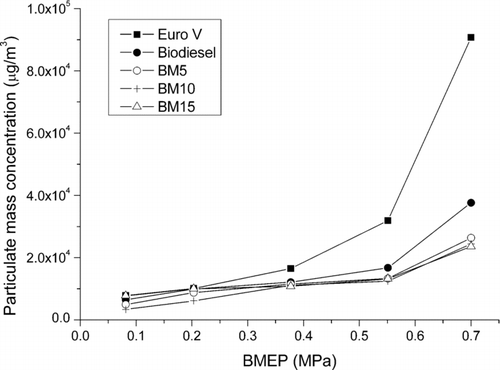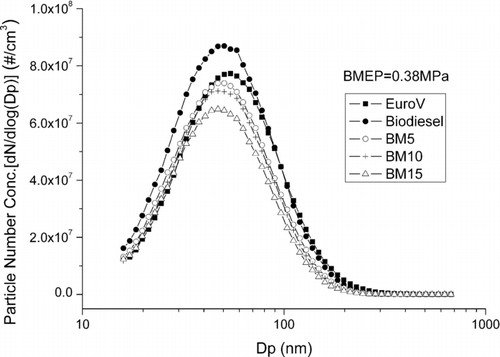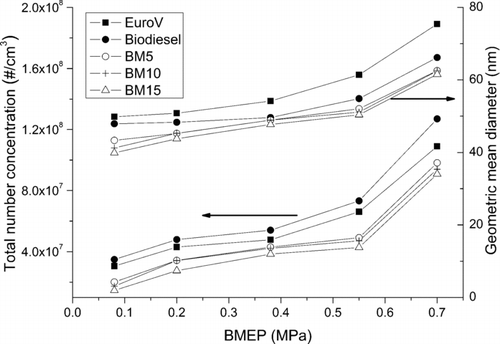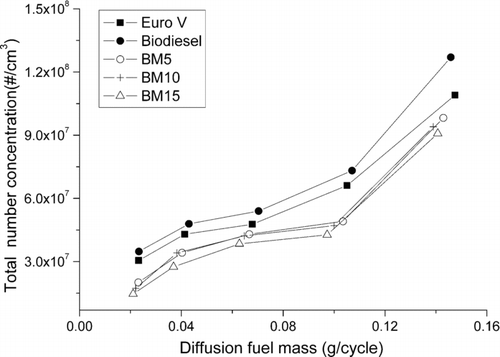Abstract
In this study, Euro V diesel fuel, biodiesel, and methanol–biodiesel blends were tested in a 4-cylinder direct-injection diesel engine to investigate the combustion characteristics and particulate emissions of the diesel engine under five engine loads at the maximum torque engine speed of 1800 rpm. Compared with Euro V diesel fuel, biodiesel gives lower and earlier heat release rate. For the blended fuels, the peak heat release rate becomes higher and retarded. With regard to particulate mass concentration, biodiesel generates less than Euro V diesel fuel, while the blended fuels result in significant reduction especially at high engine loads. Compare with Euro V diesel fuel, the total particle number concentration of using biodiesel is always higher while the geometric mean diameter (GMD) of the particles is lower. With the blended fuel, the total number concentration and GMD decrease in comparison with pure biodiesel. Further analysis shows that the difference between the total number concentration of biodiesel and Euro V diesel fuel is in particles smaller than 50 nm rather than in the larger particles. The use of methanol–biodiesel blends, compared with biodiesel, could reduce the number concentration of all sizes. A comparison between the particulate mass emission and total particulate number concentration with the mass of fuel burned in the diffusion mode show that they are strongly related to each other, even for the blended fuel.
1. INTRODUCTION
Biofuels, such as alcohol and biodiesel, which could partly or wholly replace diesel fuel, have been considered as potential alternative fuels for diesel engines. Biodiesel is renewable and non-toxic. Its properties are similar to those of diesel fuel, thus there is no need to modify the diesel engine when it is fueled with biodiesel or its blends. A number of literatures have investigated the combustion characteristics and emissions of biodiesel and found that biodiesel gives lower and earlier heat release rate, lower particulate emission but higher NOx emission (EPA 2002; CitationCanakci 2007; CitationOzsezen et al. 2009), compared with diesel fuel. The increase in NOx emissions and the poor flow characteristics in low temperature (CitationBhale et al. 2009) are considered as major impediments of biodiesel application.
The combustion process in a direct injection diesel engine can be divided into three consecutive phases: ignition delay period, premixed combustion and diffusion combustion. Diesel fuel is injected into the engine cylinder and atomized into fine droplets. During the ignition delay period, the droplets are heated up by the hot air and partially vaporized and mixed with hot air to form a combustible mixture. During the premixed combustion phase, the combustible mixture is ignited and combusted rapidly. The amount of fuel burned in the premixed mode depends in part on the ignition delay. The longer the ignition delay, the more fuel is prepared for premixed combustion. Combustion of the remaining diesel fuel is diffusion controlled, depending on the subsequent rate of mixing between oxygen and the fuel. The fuel burned in the diffusion mode is related with soot production because soot can be formed on the fuel-rich side of the diffusion flame where local temperatures are sufficiently high (CitationDec 1997). Hence, the amount of soot and particulate matter formed is related to the amount of fuel burned in the diffusion mode and the oxygen available for supporting combustion in the diffusion mode.
Methanol, when used as a fuel additive, can provide higher oxygen content in the blended fuel and increase the heat of evaporation of the blended fuel, which are advantageous for reducing both NOx and soot. Moreover, alcohols could help to improve the poor low temperature flow characteristics of biodiesel (CitationBhale et al. 2009). Thus, it is meaningful to examine the effect of methanol–biodiesel blends on the combustion and emission characteristics of a diesel engine.
The literature shows that there have been some investigations on ethanol–biodiesel blends (CitationKumar et al. 2006; Shudo et al. 2007; Bhale et al. 2009; Lebedevas et al. 2009) but very few on methanol–biodiesel blends (CitationKumar et al. 2003; CitationCheng et al. 2008). It is found that the effect of ethanol–biodiesel blend on engine performance and emissions include increase of peak pressure, ignition delay period, and heat release rate of the premixed combustion; while there is reduction of NOx, smoke, and particulate. CitationCheng et al. (2008) compared the emissions of biodiesel and a 10% methanol–biodiesel blend. They found that the disadvantage of increased NOx emission of biodiesel could be overcome by using 10% methanol in the blended mode, and at the same time the blended fuel was effective in reducing particulate both by mass and by number. However their study was limited to 10% methanol blends and did not include combustion characteristics.
Over the past few years, diesel particle number concentration and size distribution have attracted public attention. The diesel particles are mainly submicron in size. They can diffuse easily in the ambient air and could be breathed into the lung (CitationDonaldson et al. 1998). Many studies have been conducted on investigating the particle number concentration and size distribution when the engine is fueled with biodiesel (CitationTsolakis 2006; Lapuerta et al. 2008a; CitationDi et al. 2009). They concluded that the mean diameter of particles for biodiesel tended to decrease compared with diesel fuel, while results on the total particle number concentrations reported by these studies are different from each other. CitationTsolakis (2006) and CitationDi et al. (2009) reported that the use of biodiesel could increase the total number concentration and reduce the geometric mean diameter (GMD), while Lapuerta et al. (2008a) reported that both the mean diameter and mean number concentration decreased with biodiesel, compared with reference diesel fuel. However, there is nearly no literature focusing on the particle number concentration and size distribution of methanol–biodiesel blends.
Thus, the aim of this study is to compare the combustion characteristics and particulate emissions of a diesel engine fuelled with methanol–biodiesel blends, pure biodiesel, and Euro V diesel fuel, under different engine loads.
2. TEST ENGINE AND FUEL PROPERTIES
The experiments were carried out on a naturally aspirated, water-cooled, 4-cylinder, direct-injection diesel engine. The specifications of the engine are shown in . The engine was connected to an eddy-current dynamometer and a control system for adjusting the engine speed and engine torque. The fuels used in this study include Euro V diesel fuel, biodiesel and biodiesel blended with methanol. The major properties of Euro V diesel fuel, biodiesel, and methanol are shown in . Biodiesel used in this study was produced from waste cooking oil by Dunwell Petro-Chemical Ltd. The methanol–biodiesel blended fuels, or simply the BM blends, were prepared with 5%, 10%, and 15% by volume of methanol in biodiesel, and are identified as BM5, BM10, and BM15 fuels. Since methanol has higher oxygen content, thus the BM blends contain more oxygen compared with biodiesel. On the other hand, since methanol has very low cetane number, the blended fuels will have lower cetane number compared with biodiesel and hence lead to longer ignition delay.
TABLE 1 Engine specifications
TABLE 2 Properties of Euro V diesel fuel, biodiesel, and methanol
3. EXPERIMENTAL SETUP AND MEASUREMENTS
The experimental system is shown in . In this study, in-cylinder pressure signals were used to calculate the heat release rate and analyze the combustion process. The cylinder pressure was measured by a Kistler piezoelectric sensor type 6056A and the pressure signals were amplified with a Kistler charge amplifier type 5011B. The amplified pressure signals were recorded and analyzed with a combustion analyzer (DEWETRON, DEWE-ORION-0816-100x). A crank-angle encoder was employed for crank-angle signal acquisition at a rate of 720 signals per engine revolution. Particulate mass concentration was measured with a tapered element oscillating microbalance (TEOM, Series 1105, Rupprecht & Patashnick Co., Inc.). Particle number concentration and size distribution was measured with a scanning mobility particle sizer (SMPS, TSI Model 3934). Before passing through the TEOM and SMPS, the exhaust gas was diluted with a Dekati mini-diluter, which contains two stages of dilution. The dilution ratio (DR) was calculated based on the following equation:
Experiments were conducted at a steady engine speed of 1800 r/min and at five engine loads, corresponding to the brake mean effective pressures (BMEP) of 0.08 MPa, 0.20 MPa, 0.38 MPa, 0.55 MPa, and 0.70 MPa. The BMEP, which represents the useful work developed by the engine per unit displacement volume of the engine, is a commonly adopted parameter for representing engine load. At each engine operating mode, experiments were carried out for diesel fuel, biodiesel and each of the BM blends. To ensure the repeatability and comparability of the measurements, the cooling water temperature was automatically controlled by a temperature controller to 80°C, and held to within ± 2°C, while the lubricating oil temperature varied from 90 to 100°C, depending on the engine load. Data were recorded after the engine has reached the steady state, as indicated by the lubricating oil temperature and the cooling water temperature. In this study, the diesel engine was not modified during all the tests. Moreover, for minimizing cross contamination of different fuels with each other, before each test, the engine was allowed to operate with the new fuel for thirty minutes to clean the fuel system. The data were recorded continuously for 5 min and average values were presented while the experimental standard errors, as shown in , have been calculated by the method of CitationKline and McClintock (1953) and CitationAmes et al. (2000). Each test was repeated twice to ensure that the results are repeatable within the experimental uncertainties. Student's t-test was employed to analyze whether the difference between the results obtained from different fuels are statistically significant at 95% confidence level. In , the standard error of pressure is evaluated using the peak pressures obtained in the same operating condition. The same level of error is assumed in the heat release parameters which are derived from the pressure data.
TABLE 3 Experimental standard errors
4. RESULT AND DISCUSSION
4.1. Combustion Characteristics
Diesel particles are composed of soot, soluble organic fraction, and sulfate while soot is formed mainly in the diffusion phase of combustion. Hence it is important to examine combustion characteristics of the different fuels, in particular influence of the fuels on diffusion combustion characteristics. In this study, in-cylinder pressure was measured to investigate effects of methanol in the blended fuels on combustion. The in-cylinder pressure, averaged over 400 cycles, was converted into heat release rate through the DEWETRON combustion analyzer. The methods of heat release rate analysis have been covered in CitationCanakci (2007) and CitationLu et al. (2004). Basically, the First Law of Thermodynamics is applied to obtain the heat released arising from the fuel burned per crank angle.
The heat release rate curves for the different fuels are compared in for the engine loads of 0.20 MPa, 0.38 MPa, and 0.7 MPa, respectively. The premixed combustion and diffusion combustion phases are identified in the figures. All fuels give a rapid premixed combustion phase followed by a diffusion combustion phase. The diffusion combustion phase becomes more dominant at higher engine load. The peak heat release rate increases with an increase in engine load from the low to the medium, but decreases at high engine load for all test fuels, which is similar to the results of CitationLu et al. (2004). Moreover, with increase of engine load, the peak heat release rate occurs slightly closer to the TDC.
Compared with Euro V diesel fuel, the peak heat release rates of biodiesel are lower and occur earlier, which are similar to the results of CitationTsolakis et al. (2007) and CitationLeung et al. (2006). For the BM blends, the peak heat release rate increases with the increase of methanol fraction in the blended fuel and occurs further away from the TDC in comparison with biodiesel, indicating that there is a delay in the start of combustion.
To illustrate the influence on the combustion process, the start of combustion and the combustion duration are derived from the heat release rate curves and displayed in . The start of combustion is defined as the beginning of heat release. It is an indication of ignition delay; the later the combustion starts, the longer is the ignition delay. The end of combustion is defined as the crank angle where the summated heat release is 95% of the total heat released. The combustion duration is the time interval from the start of combustion to the end of combustion. Compared with Euro V diesel fuel, biodiesel has earlier start of combustion and shorter combustion duration which have been explained in the literature (CitationLeung et al. 2006; CitationTsolakis et al. 2007; CitationYu et al. 2002; CitationZiejewski et al. 1995).
For the BM blends, the start of combustion is retarded and the combustion duration is shortened, compared with both biodiesel and Euro V diesel fuel. Several factors could be attributed to the changes in the combustion characteristics. The higher peak heat release rate could be attributed to the longer ignition delay or retardation of the start of combustion because of the higher latent heat of evaporation and lower cetane number of methanol. Thus more fuel is prepared for combustion during the longer ignition delay period, leading to more fuel burned in the premixed mode. Moreover, due to the higher oxygen content of methanol, the diffusion combustion of the BM blends could be improved and the period of diffusion phase is shortened, leading to shorter combustion duration, as shown in . Finally, the microexplosion of methanol in oil droplets might permit better atomization (CitationZeng and Lee 2007), accelerate the diffusion combustion and reduce the combustion duration.
The mass of fuel burned in the diffusion mode of each cycle, which is referred to as the diffusion fuel mass in this article, can be derived from the heat release analysis and the mass of fuel consumed per cycle. From the heat release analysis, the percentage of heat released in the premixed mode and in the diffusion mode can be evaluated. The fuel is assumed to be completely burned and the percentage of fuel burned in each mode is assumed to be equal to the percentage of heat released in that mode. For the blended fuel, it is assumed that the blended fuel is uniformly combusted. The results are shown in together with the total mass of fuel consumed per cycle. For biodiesel and the BM blends, there is an increase of mass of fuel consumed per cycle. This is due to the lower heat values of biodiesel and methanol thus more fuel is consumed at the same engine load. However, the diffusion fuel mass of biodiesel and Euro V diesel fuel are statistically the same and they are higher than those of the BM blends. The diffusion fuel mass in general increases with the methanol content in the BM blends and the maximum difference is about 10% between biodiesel and the BM blends. The difference in diffusion fuel mass of biodiesel and the BM blends are statistically significant at the 95% confidence level. With the increase of engine load, the diffusion fuel mass increases for each test fuel.
4.2. Particle Mass Concentration and Number Concentration
4.2.1. Effect of Engine Load
The variation of PM mass concentration is shown in . In general, for each fuel, PM mass concentration increases with engine load, because more fuel is injected and burned in the diffusion mode. and indicate the strong relationship between PM mass concentration with mass of fuel burned in the diffusion mode, in particularly for the diesel fuel and for biodiesel.
The particle size distributions were measured at five engine loads, using the SMPS, for particles from 15 nm to 750 nm. A typical particle number concentration and size distribution curve obtained for the engine load of 0.38 MPa is shown in , while the variation of total number concentration and the geometric mean diameter (GMD) are shown in for all the five engine loads. For each fuel, with increase in the engine load, there is an increase in both total number of particles and GMD. With an increase in the engine load, more fuel is injected into the combustion chamber, which could increase the mass of fuel burned in the diffusion mode, leading to the increase in particles. Moreover, because of the longer period of diffusion combustion, there is less time for the soot particles to be oxidized after the end of the diffusion combustion period, and also there is less oxygen available for soot oxidation (CitationTsolakis 2006). This is supported by which plots the total number concentration again the diffusion fuel mass. and resemble each other indicating the strong relationship between total number concentration with mass of fuel burned in the diffusion mode, for all the fuels.
4.2.2. Comparison Between Euro V Diesel Fuel and Biodiesel
shows that, compared with Euro V diesel fuel, PM mass concentration decreases obviously when the engine is fueled with biodiesel, especially at the high engine load. Between the two fuels, it can be observed from that biodiesel in general has a higher mass of fuel consumed per cycle but almost the same mass of fuel burned in the diffusion mode, indicating that there is a larger amount of fuel burned in the premixed mode. shows that the combustion duration of biodiesel is shorter than that of Euro V diesel fuel, which indicates that combustion rate is faster, probably due to the larger amount of fuel burned in the premixed mode. Since soot is mainly formed in the diffusion phase, the use of biodiesel could improve the diffusion combustion, enhance the oxidation and hence reduce the formation of soot particles.
Despite a reduction in particulate mass concentration, however, the total number concentrations are always higher while the GMDs are always lower, for biodiesel than Euro V diesel fuel, indicating that biodiesel increases the formation of smaller particles. This is illustrated in which shows that the particle size distributions of biodiesel are displaced towards smaller size. We have evaluated the number of particles less than 50 nm, PM< 50nm , and those which are larger, PM> 50nm . At each test condition, biodiesel produces larger number concentration of PM< 50nm , and almost equal number concentration of PM> 50nm in comparison with Euro V diesel fuel. The increase in PM< 50nm is statistically significant at the 95% confidence level.
CitationTsolakis (2006) suggested that the higher viscosity and density of biodiesel will increase the fuel injection pressure, resulting in better atomization and air-fuel mixing in the combustion chamber, and hence producing a larger amount of smaller diameter particles. This is supported by CitationMathis et al. (2005), which reported a reduction of primary soot particle diameter when increasing the fuel injection pressure. Although shows that the diffusion fuel mass of biodiesel is more or less the same as that of Euro V diesel fuel, the higher oxygen content of biodiesel could improve the combustion process in locally rich diffusion flame, leading to reduction of the total mass concentration and the size of the particles. CitationMuller et al. (2003) demonstrated that oxygen in ester (such as biodiesel) or -O-(C = O)- and -OH structural groups, could improve combustion process and reduce soot formation. Moreover, biodiesel results in advanced fuel injection, which could lead to smaller primary soot particles (CitationMathis et al. 2005). In addition, compared with Euro V diesel fuel, unburned biodiesel is less volatile and hence is more liable to nucleate and condense into minute particles when the exhaust gas sample is cooled down in the tail pipe, resulting in an increase of nucleation mode particles (CitationDi et al. 2009).
4.2.3. Effect of BM Blends
The BM blends lead to an increase in the mass of fuel consumed per cycle, due to the lower heat value of methanol. Despite that, there is a reduction of mass of fuel burned in the diffusion mode, indicating that there is an increase of fuel burned in the premixed mode, and hence an improvement in combustion, leading to a reduction of the combustion duration. Improvement in combustion and reduction of diffusion fuel mass favors reduction of PM mass concentration.
shows that PM mass concentrations are reduced for the BM blends except for BM15 at low engine load. Furthermore, the difference between biodiesel and the BM blends on PM mass concentration is more obvious at high engine load. CitationOzaktas et al. (2000) studied the effect of methanol–diesel blend on soot emission. They concluded that the methanol component is relatively effective on the decrease of soot emission.
When the engine is fueled with BM blends, many factors contribute to the decrease of PM mass concentration. Firstly, compared with pure biodiesel, the BM blends have higher oxygen content but lower carbon content, which could improve the combustion process with higher heat release rate both in the premixed and the diffusion phase, suppressing the formation of PM and accelerating the oxidation of PM. Secondly, methanol could reduce the viscosity and density of the blended fuel, leading to better atomization, better air/fuel mixing and hence lower PM emissions. Thirdly, the lower cetane number of methanol will lead to longer ignition delay, as demonstrated by the delay in start of combustion shown in . The longer ignition delay period of the BM blends results in more fuel burned in the premixed mode and a reduction of fuel burned in the diffusion mode. Thus less soot and hence less PM is formed.
On the other hand, methanol has a much higher latent heat of evaporation of 1178 kJ/kg compared with both biodiesel and diesel fuel. Thus methanol blended in biodiesel could reduce the combustion temperature due to its cooling effect which deteriorates combustion and increases PM emissions. For all test cases, except for BM15 at light engine load, it is obvious that the higher oxygen content, lower viscosity, and longer ignition delay are the dominating factors. However, for BM15 at the light engine load, PM emissions may be dominated by the cooling effect, causing an increase in PM emissions arising from the condensation of unburned hydrocarbon.
Coupled with the reduction of PM mass concentration, there is a reduction in both total number concentration and GMD. For the BM blends, the particle size distribution curves become flatter, while there is still a slight shift of the particles towards smaller size. A comparison of PM< 50nm and PM> 50nm between the BM blends and biodiesel shows that the BM blends generate significantly less particles in both size groups, statistically, at the 95% confidence level. Similar comparison between the BM blends and Euro V diesel fuel shows that the BM blend generates similar level of PM< 50nm but much less PM> 50nm .
Several factors can be attributed to the decrease of total number concentration and GMD after adding methanol in biodiesel. First of all, because of the longer ignition delay period, more blended fuel combusted in the premixed mode and less fuel combusted in the diffusion mode, leading to a reduction of particles both in large diameter and small diameter, compared with biodiesel. Also, the microexplosion of methanol in oil droplets might permit better atomization (CitationZeng and Lee 2007), leading to better air-fuel mixing. CitationMathis et al. (2005) concluded that improved air-fuel mixture formation led to a reduction in both primary soot particle diameter and total number concentration of particles. Secondly, the methanol with lower viscosity could contribute to the lower injection pressure of BM blends and hence reduce the number of particles, compared with biodiesel. Thirdly, the higher oxygen content of methanol can reduce soot precursor production in the fuel-rich zone, due to an increased concentration of O and OH which promote the oxidation of soot precursors to CO and CO2, leading to reduction in the number concentration of particles (CitationTree and Svensson 2007). Finally, the higher volatility of methanol might reduce the possibility of gas-to-particles conversion for the BM blends, resulting in the reduction of particles, in comparison with that of biodiesel. Lapuerta et al. (2008b) studied the effects of ethanol–diesel blends on the particle number concentration, and suggested that the reduction in GMD of ethanol–diesel blends was not caused by an increase in smaller particles but by a decrease in larger particles. While in this study, the reduction in GMD of methanol-biodiesel blends is due to a decrease both in small particles and large particles.
5. CONCLUSION
The combustion characteristics and particulate emissions are investigated and compared for Euro V diesel fuel, biodiesel, and biodiesel–methanol blends under different engine loads. The following conclusions can be drawn from this study:
-
For each test fuel, the peak heat release rate increases from low engine load to medium engine load, and decreases from medium to high engine load. Compared with Euro V diesel fuel, biodiesel gives lower and earlier peak heat release rate in the premixed combustion phase. With the increase of methanol fraction in the BM blends, the peak heat release becomes higher and retarded.
-
The BM blends lead to an increase of mass of fuel consumed per cycle but the mass of fuel burned in the diffusion mode decreases with the BM blends, indicating that there is an increase of fuel burned in the premixed mode, arising from the increase of ignition delay.
-
For each test fuel, the particulate mass concentration and number concentration increases with the engine load due to an increase of mass of fuel burned in the diffusion mode.
-
For each fuel, the particulate mass concentration and the total number concentration increase with the mass of fuel burned in the diffusion mode which supports that particulate is formed in the diffusion mode of combustion.
-
The total number concentration of particles from biodiesel is always higher than that of Euro V diesel fuel, while the GMD is lower, at each test mode, due to an increase of particles smaller than 50 nm.
-
When the diesel engine is fueled with the BM blends, the particulate mass concentration and number concentration decreases obviously, especially at high engine loads, mainly due to the higher oxygen content of the BM blends, and also due to the reduction of mass of fuel burned in the diffusion mode.
-
With increase of methanol in the BM blends, the total number concentration and GMD decrease in comparison with pure biodiesel and even Euro V diesel fuel. Thus biodiesel and methanol have different influence on particle number concentration due to difference in fuel properties.
Thus, it can be concluded that the use of methanol–biodiesel blends is effective in reducing both particulate mass concentration and the total number concentration of particles.
The authors would like to thank the Hong Kong Polytechnic University (GU482), Key Project of Chinese Ministry of Education and Shanghai Jiaotong University for financial support to this project.
REFERENCES
- Ames , W. F. , Cain , G. and Steele , W. G. 2000 . Mathematics for Mechanical Engineers , Boca Raton, Fla : CRC Press .
- Bhale , P. V. , Deshpande , N. V. and Thombre , S. B. 2009 . Improving the Low Temperature Properties of Biodiesel Fuel . Renew Energ. , 34 : 794 – 800 .
- Canakci , M. 2007 . Combustion Characteristics of a Turbocharged DI Compression Ignition Engine Fueled with Petroleum Diesel Fuels and Biodiesel . Bioresour Technol. , 98 : 1167 – 1175 .
- Cheng , C. H. , Cheung , C. S. , Chan , T. L. , Lee , S. C. , Yao , C. D. and Tsang , K. S. 2008 . Comparison of Emissions of a Direct Injection Diesel Engine Operating on Biodiesel with Emulsified and Fumigated Methanol. . Fuel. , 87 : 1870 – 1879 .
- Dec , J. E. 1997 . A Conceptual Model of a DI Diesel Combustion Based on Laser-Sheet Imaging SAE Tec. Pap. Ser. No. 970873
- Di , Y. , Cheung , C. S. and Huang , Z. H. 2009 . Experimental Investigation on Regulated and Unregulated Emissions of a Diesel Engine Fueled with Ultra-Low Sulfur Diesel Fuel Blended with Biodiesel from Waste Cooking Oil. . Sci. Total Environ. , 407 : 835 – 846 .
- Donaldson , K. , Li , X. Y. and MacNee , W. 1998 . Ultrafine (Nanometer) Particle Mediated Lung Injury . J. Aerosol Sci. , 29 : 553 – 560 .
- EPA . 2002 . A Comprehensive Analysis of Biodiesel Impacts on Exhaust Emissions Draft tech. report, EPA420-P-02-001
- Kline , S. J. and McClintock , F. A. 1953 . Describing Uncertainties in Single Sample Experiments . Mech. Eng , 75 : 3 – 8 .
- Kumar , M. S. , Ramesh , A. and Nagalingam , B. 2003 . An Experimental Comparison of Methods to Use Methanol and Jatropha Oil in a Compression Ignition Engine . Biomass Bioenerg. , 25 : 309 – 318 .
- Kumar , M. S. , Kerihuel , A. , Bellettre , J. and Tazerout , M. 2006 . Ethanol Animal Fat Emulsions as a Diesel Engine Fuel—Part 2: Engine Test Analysis . Fuel. , 85 : 2646 – 2652 .
- Lapuerta , M. , Rodríguez-Fernández , J. and Agudelo , J. R. 2008 . Diesel Particulate Emissions from Used Cooking Oil Biodiesel . Bioresour. Technol. , 99 : 731 – 740 .
- Lapuerta , M. , Armas , O. and Herreros , J. M. 2008 . Emission from a Diesel-Bioethanol Blend in an Automotive Diesel Engine. . Fuel. , 87 : 25 – 31 .
- Lebedevas , S. , Lebedeva , G. , Makareviciene , V. , Janulis , P. and Sendzikiene , E. 2009 . Usage of Fuel Mixtures Containing Ethanol and Rapeseed Oil Methyl Esters in a Diesel Engine . Energ Fuel. , 23 : 217 – 223 .
- Leung , D. Y. C. , Luo , Y. and Chan , T. L. 2006 . Optimization of Exhaust Emissions of a Diesel Engine Fuelled with Biodiesel . Energ. Fuel. , 20 : 1015 – 1023 .
- Lu , X. C. , Yang , J. G. , Zhang , W. G. and Huang , Z. 2004 . Effect of Cetane Number Improver on Heat Release Rate and Emissions of High Speed Diesel Engine Fueled with Ethanol-Diesel Blend Fuel . Fuel. , 83 : 2013 – 2020 .
- Mathis , U. , Mohr , M. , Kaegi , R. , Bertola , A. and Boulouchos , K. 2005 . Influence of Diesel Engine Combustion Parameters on Primary Soot Particle Diameter . Environ. Sci. Technol. , 39 : 1887 – 1892 .
- Muller , C. J. , Pickett , L. M. , Siebers , D. L. , Pitz , W. J. , Westbrook , C. K. and Martin , G. C. 2003 . Effects of Oxygenates on Soot Process in DI Diesel Engines: Experiments and Numerical Simulates SAE Tec. Pap. Ser. No. 2003-01-1791
- Ozaktas , T. , Ergeneman , M. , Karaosmanoglu , F. and Arslan , H. E. 2000 . Ignition Delay and Soot Emission Characteristics of Methanol-Diesel Fuel Blends . Petroleum Sci. Technol. , 18 : 15 – 32 .
- Ozsezen , A. N. , Canakci , M. , Turkcan , A. and Sayin , C. 2009 . Performance and Combustion Characteristics of a DI Diesel Engine Fueled with Waste Palm Oil and Canola Oil Methyl Esters . Fuel. , 88 : 629 – 636 .
- Shudo , T. , Hiraga , K. and Ogawa , H. 2007 . Mechanisms in Reducing Smoke and NOx from BDF Combustion by Ethanol Blending and EGR SAE Tec. Pap. Ser. No. 2007-01-0622
- Tree , D. R. and Svensson , K. T. 2007 . Soot Processes in Compression Ignition Engines . Prog. Energ. Combust. Sci. , 33 : 272 – 309 .
- Tsolakis , A. 2006 . Effects on Particle Size Distribution from the Diesel Engine Operating on RME-Biodiesel with EGR . Energ. Fuel. , 20 : 1418 – 1424 .
- Tsolakis , A. , Megaritis , A. , Wyszynski , M. L. and Theinnoi , K. 2007 . Engine Performance and Emissions of a Diesel Engine Operating on Diesel-RME (Rapeseed Methyl Ester) Blends with EGR (Exhaust Gas Recirculation) . Energ. , 32 : 2072 – 2080 .
- Yu , C. W. , Bari , S. and Ameen , A. 2002 . A Comparison of Combustion Characteristics of Waste Cooking Oil with Diesel as Fuel in a Direct Injection Diesel Engine. . Proc. Instn Mech. Engrs. Part D: J. Automobile Engineering. , 216 : 237 – 243 .
- Zeng , Y. B. and Lee , C. F. 2007 . Modeling Droplet Breakup Processes Under Micro-Explosion Condition . P. Combust. Inst. , 31 : 2185 – 2193 .
- Ziejewski , M. , Goettler , H. J. , Hainess , H. and Chor , H. 1995 . Comparative Analysis of Plant Oil Based Fuels SAE Tec. Pap. Ser. No. 952061
